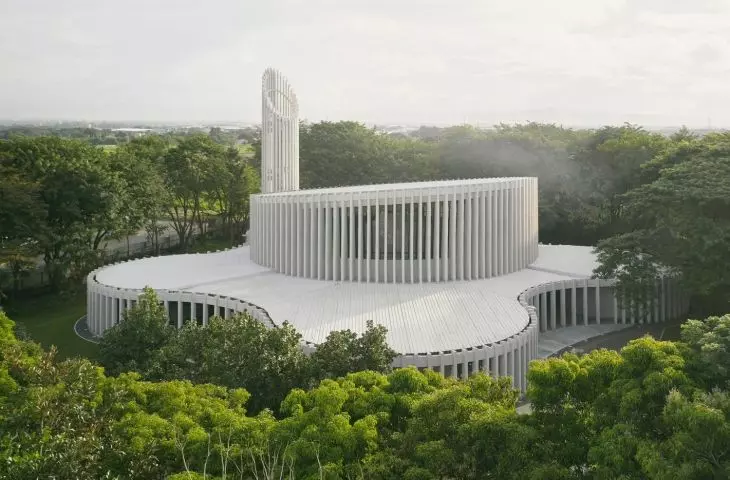Sanctuary de La Salle,
design: CAZA
Sanctuary de La Salle is a modern interpretation of sacred architecture, located on the campus of De La Salle University in Biñan, Philippines. The church was designed by design studio Carlos Arnaiz Architects (CAZA), based in Brooklyn and with think tanks in Manila (Philippines), Bogotá (Colombia) and Lima (Peru). The studio creates conceptual environments, buildings and urban plans.
We explore how architecture can shape meaningful experiences, enhance context, connect people to place and heritage, and ensure a more sustainable future.
- the architects write about themselves
Sanctuary de La Salle - view of the building
© Rory Gardiner
Sanctuary de La Salle
- A bridge between faith and community
The building serves as both a church and a community space, fitting perfectly with CAZA's philosophy of creating architecture that enriches the context of its surroundings and builds a connection between people and place and their heritage.
Sanctuary de La Salle - temple tower
© Rory Gardiner
The Sanctuary won the prestigious A+ Award 2023 in the category of Sacred Buildings and Memorials, reinforcing its position as an exceptional example of religious architecture.
The vertical rhythm of the Sanctuary de La Salle
© Rory Gardiner
A tranquility in the heart of the Biñan campus
Surrounded by lush vegetation, the church is isolated from the bustling university campus, creating a place of tranquility. Its name refers to the patron saint of teachers, St. John the Baptist de La Salle, and the space was designed with a new approach to spiritual openness in mind to respond to the needs of educators, students and the local community.
The sanctuary blends harmoniously with the surrounding nature
© Rory Gardiner
alabaster architecture
in harmony with nature
The exterior of the building stands out with its organic white form, contrasting with the surrounding landscape. Only the tower with its subtle cross refers to the religious function of the church. The use of raw, textured materials allows the building to blend harmoniously into its natural surroundings.
Sanctuary de La Salle - vertical slats create a harmonious texture, emphasizing the modern character of the sanctuary
© Rory Gardiner
Vertical slats and openwork facade
The sanctuary consists of solids with a rounded, irregular shape, which give the building an organic form. The outer layer is covered with vertical slats, which brings lightness and transparency to the massive structure and gives rhythmicity to the entire facade.
Sanctuary de La Salle - site plan of the temple
© CAZA
The use of white emphasizes the sanctuary's connection to the sacred realm. These vertical slats create semi-open spaces that gradually introduce visitors to the more secluded, sacred areas inside the building.
Sanctuary de La Salle facade details
© Rory Gardiner
Symbolism and functionality -
interior of Sanctuary de La Salle
The building has fourteen separate entrances, symbolizing each person's search for meaning. The interior consists of a series of circular rooms, connected by passageways, which are suitable for a variety of religious events, both formal and less formal.
Sanctuary de La Salle - the facade's slats introduce a play of light and shadow
© Rory Gardiner
The main two-story central hall is distinguished by its use of wood and brass, and is decorated with star-like lamps.
Sanctuary de La Salle - the main nave of the sanctuary
© Rory Gardiner
space for spiritual reflection
In a crowded university, Santuario de La Salle offers a space for reflection where everyone can feel part of a religious community and nature. The building integrates culture with ecology, providing a new definition of spiritual openness.
Elaborated: Anastazja Dżupina
Illustrations provided courtesy of CAZA studio.















































































